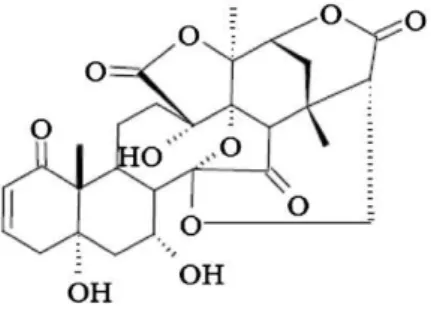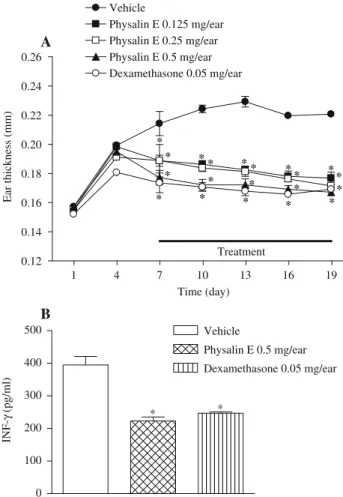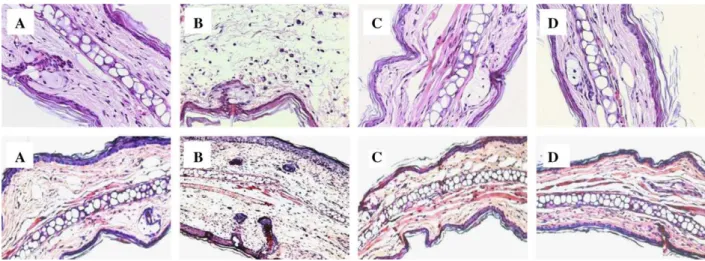Short Communication
Topical anti-inflammatory potential of Physalin E from
Physalis angulata
on
experimental dermatitis in mice
N.B. Pinto
a, T.C. Morais
a, K.M.B. Carvalho
b, C.R. Silva
a, G.M. Andrade
a, G.A.C. Brito
c, M.L. Veras
d,
O.D.L. Pessoa
d, V.S. Rao
a, F.A. Santos
a,naDepartments of Physiology and Pharmacology, Federal University of Ceara´, Cel Nunes de Melo 1127, Porangabussu, P.O.B - 3157, 60430-270 Fortaleza, Ceara´, Brazil bDepartments of Clinical Medicine, Federal University of Ceara´, Cel Nunes de Melo 1127, Porangabussu, P.O.B - 3157, 60430-270 Fortaleza, Ceara´, Brazil
cDepartments of Morphology, Federal University of Ceara´, Cel Nunes de Melo 1127, Porangabussu, P.O.B - 3157, 60430-270 Fortaleza, Ceara´, Brazil
dDepartment of Organic and Inorganic Chemistry, Federal University of Ceara´, Cel Nunes de Melo 1127, Porangabussu, P.O.B - 3157, 60430-270 Fortaleza, Ceara´, Brazil
a r t i c l e
i n f o
Keywords:
Physalin E
Physalis angulata
Solanaceae TPA Oxazolone
Anti-inflammatory effect
a b s t r a c t
The anti-inflammatory effect of physalin E, a seco-steroid isolated from Physalis angulata L. was evaluated on acute and chronic models of dermatitis induced by 12-O-tetradecanoyl-phorbol-13-acetate (TPA) and oxazolone, respectively, in mouse ear. The changes in ear edema/thickness, production of pro-inflammatory cytokines (TNF-a and IFN-g), myeloperoxidase (MPO) activity, and
histological and immunohistochemical findings were analysed, as indicators of dermal inflammation. Similar to dexamethasone, topically applied Physalin E (0.125; 0.25 and 0.5 mg/ear) potently inhibited the TPA and oxazolone-induced dermatitis, leading to substantial reductions in ear edema/thickness, pro-inflammatory cytokines, and MPO activity. These effects were reversed by mifepristone, a steroid antagonist and confirmed by immunohistochemical and histopathological analysis. The data suggest that physalin E may be a potent and topically effective anti-inflammatory agent useful to treat the acute and chronic skin inflammatory conditions.
&2010 Elsevier GmbH. All rights reserved.
Introduction
Physalin E (Fig. 1) is a naturally occurring seco-steroid isolated from the stems and aerial parts ofPhysalis angulataL. (Solanaceae) (Bastos et al., 2008). Extracts/infusions from this plant are popularly used to treat inflammatory and painful conditions like sore throat, rheumatism, hepatitis and cervicitis (Bastos et al., 2008). The anti-inflammatory and immunomodulatory effects of plant-derived physalins B, D, F and G, but not of physalin E have been well documented (Soares et al., 2003; Vieira et al., 2005; Jacobo-Herrera et al., 2006; Magalhaes et al., 2006;~ Damu et al., 2007;Guimaraes et al., 2009).~
The prevalence of atopic dermatitis and allergic or irritant contact dermatitis has been increasing significantly in the general population, causing considerable economic costs and decreased quality of life (Po´nyai et al., 2007). Studies reveal that a large percentage of patients use some form of complementary and alternative medicine for the treatment of atopic and contact dermatitis, which include herbal remedies (Simpson et al., 2003; Nicolaou and Johnston, 2004). Recently, Guimaraes et al., 2009~
have shown that topical treatment with physalins purified from P. angulatareduce the skin lesions in cutaneous leischmaniasis. Physalin E, being a seco-steroid, structurally related to other physalins, an anti-inflammatory action is expected. Thus, this study was aimed to evaluate its topical anti-inflammatory potential, using the TPA and the oxazolone models of cutaneous dermatitis, commonly employed to test the compounds efficacy against contact/atopic dermatitis (Zhang and Tinkle, 2000; Murakawa et al., 2006).
Materials and methods
Plant material, extraction and isolation of Physalin E
The aerial parts of Physalis angulata were collected from Pentecoste County, Ceara´, Brazil, after its identification by Prof Edson P. Nunes. A voucher sample (No. 33.576) has been deposited at the Herbarium Prisco Bezerra of this University. Air-dried and grounded plant material (4.3 kg) was percolated with hexane (2 x 10 l) followed by EtOH (2 x 10 l) at room temperature. The hexane and EtOH extracts were filtered and concentrated under reduced pressure to yield 1.5 g and 70.0 g of crude extracts, respectively. The EtOH extract was fractioned over
ARTICLE IN PRESS
Contents lists available atScienceDirect
journal homepage:www.elsevier.de/phymed
Phytomedicine
0944-7113/$ - see front matter&2010 Elsevier GmbH. All rights reserved. doi:10.1016/j.phymed.2010.01.006
n
Corresponding author. Tel.: +55 85 33668341; fax: +55 85 33668333.
E-mail address:flavia@ufc.br (F.A. Santos).
ARTICLE IN PRESS
silica gel using hexane, CH2Cl2, EtOAc and MeOH as eluents. The
EtOAc fraction (25 g) was chromatographed over silica gel using increasing amounts of hexane-EtOAc and EtOAc to obtain 9 fractions. Fraction 3 (4.6 g), obtained by elution with hexane-EtOAc (3:7), was rechromatographed over silica gel to afford a white precipitate by elution with CH2Cl2-EtOAc (4:6). This
material was recrystallized in acetone to yield a pure compound (1), which was identified as physalin E (1.2 g, mp 302-3051C). The
1H and13C NMR data are in agreement with the literature (Row
et al., 1978;Magalhaes et al., 2006).~
Drugs
12-O-tetradecanoyl-phorbol-13-acetate (TPA), oxazolone, dex-amethasone, hexadecyltrimethylammonium bromide, o -dianisi-dine dihydrochloride, hydrogen peroxide, formaldehyde, Tween 80 were from Sigma Chemical Co. (St. Louis, MO, U.S.A).
Animals
Male Swiss mice (20-25 g) obtained from the central Animal House of this University, were maintained in propylene cages, under standard conditions (2472oC; 12 h light-12 h dark cycle,
and relative humidity55%) with free access to food and water. Experimental protocols were approved by the Institutional Committee on Care and Use of Animals for experimentation in accordance with the ethical guidelines of National Institute of Health, Bethseda,U.S.A.
TPA-induced acute ear edema
Mice in groups (n=8) were treated on their right ear with physalin E (0.125; 0.25 and 0.5 mg/ear, 20
ml), vehicle (2% Tween
80, 20ml) or dexamethasone (0.05 mg/ear, 20
ml) prior to topical
application of 12-O-tetradecanoyl-phorbol-13-acetate (TPA, 2.5m
g/ear, 20m
l) (Recio et al., 2000). To verify the possible involvement of glucocorticoid receptor, animals were pre-treated with mifepristone (25 mg/kg, s.c.) 15 minutes prior to Physalin E (0.25 mg/ear) or dexamethasone. Ear thickness/swelling as an indicator of skin inflammation/edema was measured using a Digital Caliper (100.174B/DIGIMESSs) before TPA application and 4 h after. Ear punch biopsies (5 mm) were collected, weighed, and were fixed in 10% buffered formalin solution and processed for histological or immunohistochemical analyses.Oxazolone-induced chronic dermatitis
Contact dermatitis was induced in mouse ear according toShin et al. (2005). Groups of animals (n=8) were sensitized by application of 100
m
l of 1.5% oxazolone to the abdomen. Then a total of 20ml of 1% oxazolone was applied to the mouse ear, once
in 3 days starting from day-7 after sensitization till the day-19.Ear thickness was measured using a digital caliper, 72 h after each application of the oxazolone. Physalin E, vehicle or dexametha-sone were topically applied (at concentrations described earlier), 30 min before and 3 h after each application of oxazolone. Ear punch biopsies (5 mm) were collected, weighed, and processed for immunohistochemical study.
Assays
The degree of neutrophil infiltration was quantified by the measurement of ear myeloperoxidase (MPO) activity (Bradley et al., 1982). The ear tissue TNFaand INF-gwere measured with an ELISA kit (Quantikines, R&D Systems, Minneapolis, USA).
Immunohistochemistry
In brief, paraffin sections were deparaffinized and hydrated, and then followed with antigen reparation. After blocking with endogenous peroxydase by 3% hydrogen peroxide, sections were Fig. 1.Structure of physalin E.
0.00 0.05 0.10 0.15 0.20 0.25 0.30
a
a a a
b b Vehicle
Physalin E 0.125 mg/ear Physalin E 0.25 mg/ear
Physalin E + Mifepristone Dexamethasone + Mifepristone Physalin E 0.5 mg/ear Dexamethasone 0.05 mg/ear
Ear thickness (mm)
0.00 0.02 0.04 0.06 0.08 0.10
a a
a
a
b b
MPO activity (470nm)
0 4 8 12 16 20
a a
b b
TNF-α
(pg/mL)
Fig. 2.Effect of topical application of Physalin E on TPA-induced acute ear edema (A), myeloperoxidase activity (B) and on the levels of TNFa(C), and its reversal by mifepristone. Physalin E and dexamethasone were applied immediately before TPA. Mifepristone (25 mg/kg, s.c.) was administered 15 minutes prior to physalin E (0.25mg/ear) or dexamethasone. Each column represents mean7SEM of 8 animals per group.apo0.05 vs. vehicle group;bpo0.05 vs. respective control
group.
ARTICLE IN PRESS
incubated with primary rabbit anti-TNFa antibody (1:100) or anti-NF-kB p65 antibody (1:50). The slides were then incubated with biotinylated goat anti-rabbit secondary antibody (1:400) and incubated with avidin-biotin-horseradish peroxidase conjugate (VectastainsABC kit, Vector Laboratories, Burlingame, CA, USA). TNF-a and NF-kB were visualized with the chromogen 3,3
‘diaminobenzidine (DAB)and counterstained with Harry’s hema-toxylin, mounted, and assessed by light microscopy.
Statistical analysis
Results are expressed as mean 7 SEM. Multiple comparisons were performed using one-way ANOVA followed by Student Newman Keul’s test. Differences were considered significant at po0.05.
Results and discussion
Topical application of TPA is a valid model to screen compounds effective for potential topical anti-inflammatory therapy (Murakawa et al., 2006). In the present study, TPA induced an acute ear edema response associated with an increase in TNFaand myeloperoxidase (MPO) activity, at 4 h following its application (Fig. 2), effects consistent with the observations of Murakawa et al. (2006). Physalin E (0.125; 0.25 and 0.5 mg/ear) significantly reduced the ear edema response by 33%, 38% and 39%, and the MPO activity by 47%, 61% and 68%, respectively. Dexamethasone (0.05 mg/ear) also significantly suppressed the ear edema and MPO activity by 42% and 95%, respectively. Pretreatment with mifepristone, a glucocorticoid antagonist was able to abolish these effects of Physalin E and dexamethasone, suggesting a possible blockade of glucocorticoid receptor. Our histological analysis of the ear tissue clearly confirmed these findings (Fig. 5, upper panel).
Repeated application of oxazolone to sensitized mice caused an increase in ear thickness with a concomitant increase in tissue levels of IFN-g. This increase was apparent from day 4 onwards and stayed all throughout the experimental period. Both physalin E and dexamethasone significantly suppressed the oxazolone-induced increase in ear thickness and INF-glevel (Fig. 3). Pretreatment with mifepristone could almost abolish these effects, suggesting their usefulness in skin diseases such as psoriasis or atopic dermatitis wherein IFN-
g
plays a crucial role. Histological analysis of the ear tissue further confirmed these findings (Fig. 5, lower panel).In the immunohistochemical study, control mice demon-strated very mild pattern of TNF-
a
and NF-k
B immuno-staining (Fig. 4). On the other hand, while there was a high intensity immuno-staining for TNF-a and NF-kB in TPA untreated group,Fig. 4.Effect of Physalin E on TNFaimmunoreactivity (upper panel) and NF-kB immunoreactivity (lower panel) in mice on TPA-induced acute dermatitis. A: normal
control group showing basal immunostaining; B: vehicle + TPA showing increased dermis and epidermis immunostaining; C: physalin E (0.25 mg/ear) + TPA and D: dexamethasone (0.05 mg/ear) + TPA showing immunostaining comparable to control group.
1 4 7 10 13 16 19 0.12
0.14 0.16 0.18 0.20 0.22 0.24 0.26
Vehicle
Physalin E 0.125 mg/ear Physalin E 0.25 mg/ear Physalin E 0.5 mg/ear
Time (day) Treatment *
* * * *
* * *
* *
* * * *
* *
*
* * *
Dexamethasone 0.05 mg/ear
Ear thickness (mm)
0 100 200 300 400 500
* *
Physalin E 0.5 mg/ear Dexamethasone 0.05 mg/ear Vehicle
INF-γ
(pg/ml)
Fig. 3.The effect of topical physalin E and dexamethasone on the ear thickness (A) and levels of INF-gin ear tissue homogenates (B). Each symbol and vertical bar represents the mean7SEM for 8 animals.apo0.05 vs. vehicle group;bpo0.05
vs. respective control group.
N.B. Pinto et al. / Phytomedicine 17 (2010) 740–743
ARTICLE IN PRESS
mice pretreated with physalin E (0.25 mg/ear) or dexamethasone (0.05 mg/ear) showed far less immunostaining for both TNF-aand NF-kB. Physalins B and F that possess a double band and an epoxy ring between carbons 5 and 6 are said to function as modulators of NF-kB cascade (Jacobo-Herrera et al., 2006). Since physalin E has a similar structural epoxy ring, and inhibited NF-kB immunoreactivity, its anti-inflammatory action may, in part, involve the NF-kB modulation.
Physalin E being a seco-steroid is likely to interact with glucocorticoid receptor and exert an anti-inflammatory action. Pretreatment with glucocorticoid receptor antagonist mifepris-tone (RU 486) completely reversed the inhibitory effect of physalin E and dexamethasone on TPA-induced ear edema, increase in MPO activity and on TNFalevels. Our results are in agreement with the findings ofVieira et al. (2005)who described the mifepristone preventable anti-inflammatory action of physa-lins B and F in the ischemia/reperfusion model. The glucocorti-coids involve actions on circulating cellular and cytokine mediators of inflammation as well as on the peripheral vascu-lature. Unlike physalins B, D, and F, which exhibit both anti-inflammatory and cytotoxicity effects (Damu et al., 2007), physalin E is free from cytotoxicity (Magalhaes et al., 2006) and~ therefore may have an advantage over currently used therapeutic agents against inflammatory dermatoses.
Psoriasis and atopic dermatitis are chronic and relapsing inflammatory diseases of the skin associated with various immunologic abnormalities (Bowcock and Cookson, 2004). Two universal features of psoriasis are epidermal hyperplasia and inflammation and drugs that inhibit these events are useful to treat psoriasis. The results of this investigation provide the first time evidence of anti-proliferative and anti-inflammatory actions of physalin E, suggesting its usefulness to combat inflammatory dermatoses, including psoriasis and atopic dermatitis. However, a detailed study is warranted on its safety pharmacology.
References and further reading may be available for this article. To view references and further reading you mustpurchase this article.
Acknowledgements
This research was supported by grants and fellowships from CNPq and CAPES/Brazil and FUNCAP/Ceara´. The authors are
grateful to Francisco Alison Quintino Braga and Anyssa Quintino de Miranda for technical assistance.
References
Bastos, G.N., Silveira, A.J., Salgado, C.G., Picanc-o-Diniz, D.L., do Nascimento, J.L.,
2008. Physalis angulataextract exerts anti-inflammatory effects in rats by inhibiting different pathways. J. Ethnopharmacol. 118, 246–251.
Bowcock, A.M., Cookson, W.O.C.M., 2004. The genetics of psoriasis, psoriatic arthritis and atopic dermatitis. Hum. Mol. Genet. 13, R43–R55.
Bradley, P.P., Priebat, D.A., Christensen, R.D., Rothstein, G., 1982. Measurement of cutaneous inflammation: estimation of neutrophil content with an enzyme marker. J. Invest. Dermatol. 78, 206–209.
Damu, A.G., Kuo, P.C., Su, C.R., Kuo, T.H., Chen, T.H., Bastow, K.F., Lee, K.H., Wu, T.S., 2007. Isolation, structures, and structure cytotoxic activity relationships of withanolides and physalins fromPhysalis angulata. J. Nat. Prod. 70, 1146–1152. Guimaraes, E.T., Lima, M.S., Santos, L.A., Ribeiro, I.M., Tomassini, T.B., Dos Santos,~
R.R., Dos Santos, W.L., Soares, M.B., 2009. Activity of physalins purified from
Physalis angulatainin vitroandin vivomodels of cutaneous leishmaniasis. J. Antimicrob. Chemother. 64, 84–87.
Jacobo-Herrera, N.J., Bremner, P., Marquez, N., Gupta, M.P., Gibbons, S., Mun˜oz, E., Heinrich, M., 2006. Physalins fromWitheringia solanaceaas modulators of the NF-kappaB cascade. J. Nat. Prod. 69, 328–331.
Magalhaes, H.I.F., Veras, M.L., Pessoa, O.D.L., Silveira, E.R., Moraes, M.O., Pessoa, C.,~
Costa-Lotufo, L.V., 2006. Preliminary investigation of structure-activity relationship of cytotoxic physalin. Lett. Drug Des. Discovery 3, 625–632. Murakawa, M., Yamaoka, K., Tanaka, Y., Fukuda, Y, 2006. Involvement of tumor
necrosis factor (TNF)-alpha in phorbol ester 12-O-tetradecanoylphorbol-13-acetate (TPA)-induced skin edema in mice. Biochem. Pharmacol. 9, 1331–1336. Nicolaou, N., Johnston, G.A., 2004. The use of complementary medicine by patients
referred to a contact dermatitis clinic. Contact Dermatitis 51, 30–33. Po´nyai, G., Temesva´ri, E., Ka´rpa´ti, S., 2007. Adulthood atopic dermatitis:
epidemiol-ogy, clinical symptoms, provoking and prognostic factors. Orv. Hetil. 148, 21–26. Recio, M.C., Giner, R.M., Uriburu, L., Ma´n˜ez, S., Cerda´, M., De la fuente, J.R., Rı´os, J.L., 2000.In vivoactivity of pseudoguaianolide sesquiterpene lactones in acute and chronic inflammation. Life Sci. 66, 2509–2518.
Row, L.R., Sarma, N.S., Matsuura, T., Nakashima, R., 1978. New physalins from
Physalis angulataandP. lancifolia. Part 1. Physalins E and H, new physalins from
Physalis angulataandP. lancifolia. Phytochemistry 17, 1641–1645.
Shin, Y.W., Bae, E.A., Kim, S.S., Lee, Y.C., Kim, D.H., 2005. Effect of ginsenoside Rb1 and compound K in chronic oxazolone-induced mouse dermatitis. Int. Immunopharmacol. 5, 1183–1191.
Simpson, E.L., Basco, M., Hanifin, J., 2003. A cross-sectional survey of complemen-tary and alternative medicine use in patients with atopic dermatitis. Am. J. Contact Dermatitis 14, 144–147.
Soares, M.B., Bellintani, M.C., Ribeiro, I.M., Tomassini, T.C., Ribeiro dos Santos, R., 2003. Inhibition of macrophage activation and lipopolysaccaride-induced death by seco-steroids purified fromPhysalis angulataL. Eur. J. Pharmacol. 459, 107–112. Vieira, A.T., Pinho, V., Lepsch, L.B., Scavone, C., Ribeiro, I.M., Tomassini, T.,
Ribeiro-dos-Santos, R., Soares, M.B., Teixeira, M.M., Souza, D.G., 2005. Mechanisms of the anti-inflammatory effects of the natural secosteroids physalins in model of intestinal ischemia and reperfusion injury. Br. J. Pharmacol. 146, 244–251. Zhang, L., Tinkle, S.S., 2000. Chemical activation of innate and specific immunity in
contact dermatitis. J. Invest. Dermatol. 115, 168–176.
Fig. 5.Histological sections of mouse ear from TPA-treated (upper panel) or oxazolone-treated (lower panel). Vehicle-treated mice (A) showing normal.structure and TPA or oxazolone-treated mice (B) showing intense dermal edema, hemorrhage, inflammatory cell infiltration with the presence of mononuclear and polymorphonuclear cells. Treatment with physalin E (0.5 mg/ear) (C) or dexamethasone (0.05 mg/ear) (D) prevented the dermal edema, hemorrhage, and the inflammatory cell infiltration. Hematoxylin-eosin, x100.


